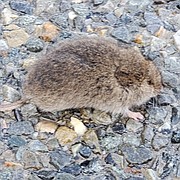Meadow voles are active year-round
“How much I’d always envied the tight life of voles. The hidey hole was happiness.”
— Author Sam Lipsyte
Last week while driving in the vicinity of Deep Creek I saw a small, gray, mouse-like creature scurrying through the thick grass and across the road. I was fortunate enough to take several pictures of the small creature. It was a vole. Some people call it a meadow vole, field mouse or meadow mouse.
Meadow voles (Microtus pennsylvanicus) are small mammals about 5-8 inches long and weigh about as much as a slice of bread. The fur on their backs is colored brown to grayish-brown. The meadow vole is common to Boundary County and can be found across the state. They are one of the most common and prolific small mammals in North America.
Although tiny, these little rodents are important. They provide food for many other animals — everything from hawks and owls to snakes, foxes and coyotes. They are often referred to as one of the most important prey species in the wild. Even big grizzly bears dine on the tiny voles.
I may have seen this vole because it has been a relatively wet year, producing lots of grass and other vegetation, which voles eat. Thick grass might also make it easier for the voles to avoid being eaten. They are also capable of having a bunch of babies each year: five to 10 litters with three to six young in each litter. If you do the math, that means a single female vole could have up to 60 baby voles if it lived for an entire year.
Primarily terrestrial and active all year, meadow voles can swim but have never been seen climbing. They are more active during the day in habitats with dense cover and at night when temperatures are high. In addition to meadows, they are found in swampy pastures, fields covered with dead grass and herbs, and sometimes grassy openings in forests.
Preferred habitats include moist fields of grass that provide thick protective cover. They dwell both above and below the ground but spend a higher proportion of time on the surface, traveling along networks of trails and tunnels through meadow vegetation to forage for food. Their diet comprises grasses (including seeds) and tender tree bark. Roots, tuber, and other plant parts are cached in a burrow to eat during the winter. Voles construct nests of dry grass either on the ground or at the ends of underground burrows.
Not many voles live very long, though. Their average lifespan is about three to six months. The maximum lifespan in the wild is 16 months.
After winter when the snow melts in the spring, you may see the little tunnels through the dead grass that voles used during the winter. They are active year-round, even though you may not see them.
Discover Boundary County’s Wildlife. Enjoy the outdoors.



